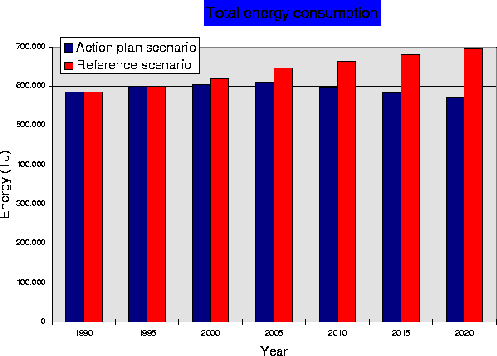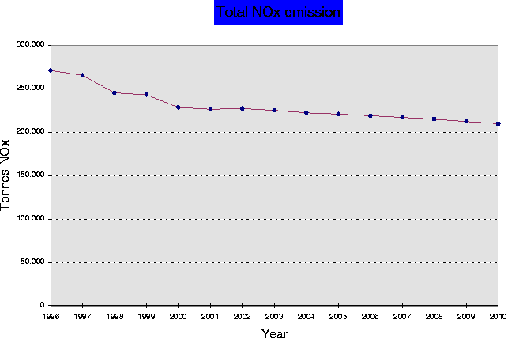
Danish subproject
Emission task
Lise Frohn, Gary Geernaert
National Environmental Research Institute, Denmark
Objectives
The Danish collaborating departments within NERI in the EU/LIFE-funded
LIFE-IEA project is two departments of the National Environmental Research
Institute, namely Department of Atmospheric Environment (ATMI) and Department
of Terrestrial Ecology (TERI). The two Danish tasks include projection
of emissions (done at ATMI) and assessment of impacts (done at TERI).
The main objective of the emission task is to develop emission estimates
and projections of SO2, NOx, NMVOC and NH3
for the period 1998 through 2010. The idea is by innovative use of existing
software to test some of the already recognized projection tools. Furthermore
the basic data for emission projections will be evaluated.
Methods
The projected emissions are calculated from two sources: projected energy
consumption data and knowledge of future technology and emission control.
In this project the latter two are incorporated in the projected emission
factor.
The software tool is the CORINAIR system CollectER, developed
for the European Environment Agency by Spirit Inc. Information Systems
(Eggleston & Pulles 1997, Pulles et al. 1998). CollectER is
developed for compiling the annual CORINAIR emission inventories using
the selected nomenclature for air pollution (SNAP), but it is also possible
to use the SNAP codes when compiling projected emissions, if knowledge
of projected emission factors and energy consumption is available.
Data
In order to compile emission projections, the necessary basic data are
projected energy consumption data and projected emission factors. For the
Danish contribution energy consumption data based on two different scenarios
have been obtained from the Danish Energy Agency (Ministry of Environment
and Energy, 1996). The first scenario is a so-called "business as usual"
scenario (the reference scenario), based on existing directives and legislation.
In this scenario it is assumed that no further technological developments
will take place.
The second scenario (the maximum action scenario) includes all of the
reduction initiatives for energy consumption given by the Danish Energy
Action Plan, e.g. a realisation of a biomass action plan (replacement of
power plants by biomass plants), massive conversion to renewables, further
extension of heat and power based on natural gas as well as an enlargement
of the wind and solar power sector.
Furthermore the data in this scenario are based on assumptions concerning
the efficiency of future cars (increase in number of kilometers driven
per liter fuel from 14 km/liter to 40 km/liter) as well as legislation
on energy efficiency (labelling og electrical devices, building elements
and cars). The projected energy consumption data can be seen in Figure
1.
Based on these energy consumption data two emission factor scenarios
are calculated. The first using emission factors from the current CORINAIR
inventories (business as usual) and the second using emission factors based
on assumptions of the best available technology (BAT).

Figure
1
Results
The resulting data will consist of a final database for the year 2010 for
each scenario. Furthermore the temporal development in the different scenarios
will be studied through intermediate databases for the years 2000 and 2005.
The result of combining the two energy scenarios with the two emission
factor scenarios is four different emission scenarios. The combinations:
Reference
energy - current emission factors and Maximum action - emission
factors based on BAT will to some degree provide the limits on future
emissions. The upper limit (business as usual) can be compared to other
unabated emission projections (like projections calculated with the RAINS
model, Amann et al. 1998). The lower limit can be compared to other official
projections, based on the same energy statistics (like the official national
projections made for the UNECE, Fenhann 1999).
The combinations: Reference energy - emission factors based on BAT
and Maximum action - current emission factors provide information
on the importance of technological development (emission factors) vs reduction
in energy consumption especially when the cost curves for the different
scenarios are considered.
So far some of the already compiled national emission scenarios have
been investigated. One of the official projections of NOx emissions
is compiled by Risoe National Laboratory (Fenhann 1999) based on the Action
plan scenario, see Figure 2. The decrease in NOx emissions partly
reflects the power plant legislation (planned quota of emissions), partly
the assumption that in 2010, 90 % of all cars will be equipped with a catalyst.

Figure
2
Conclusions
Developing emission scenarios is a quite complicated task, since the result
of a projection depends crucially on the basic data assumptions regarding
energy consumption projections and future emission control. For this reason
one of the aims of this project is to document the basic data and compare
them to the daa used for compiling similar projections for Denmark. Another
outcome of this project is the use of CollectER for compiling emission
projections. Finally the calculated emissions will be compared to projected
emissions compiled using other methods and tools, such as other national
emission projections as well as projections made with the RAINS model.
References
Amann M., Bertok I., Cofala J., Gyarfas F., Heyes C., Klimont Z., Makowski
M., Schopp W. and Syri S. 1998. Cost-effective control of acidification
and ground-level ozone. Part C: Acidification and eutrophication
scenarios. Fifth Interim report, prepared for the 21st meeting
of the UNECE Task Force on Integrated Assessment Modelling. International
Institute for Applied Systems Analysis, Laxenburg, Austria.
Danish Ministry of Environment and Energy: "Energy 21" - The Government
energy action plan 1996.
Fenhann, J. 1999. Projections of emissions to the air of greenhouse
gases from Danish sources. Risoe National Laboratory. To be published.
Eggleston S. and Pulles T. 1997. Redesigning the CORINAIR software;
a proposed design, Final draft April 1997. Prepared for the European
Environment Agency by the European Topic Centre on Air Emissions.
Pulles T., Mareckova K., Skakala J. and Svetlik J. 1998. TrainER,
Collecting a national Emission Inventory using the CollectER software,
European Topic Centre on Air Emissions, June 1998.
Deliverables
Progress Report 1 (March 31, 1998)
Progress Report 2 (September 30, 1998)
Project Group
Gary Geernaert (ATMI), Project Coordinator
Lise Frohn (ATMI)
Emissions
Jesper Bak (TERI),
Impacts
Related pages
Coupling
of CORINAIR data to cost-effective emission reduction strategies based
on critical thresholds
home page (LIFE 97/ENV/FIN/336)
This page is maintained by Lise
Marie Frohn
It was last modified on May 10, 1999
Published by the Department of Atmospheric
Environment, National Environmental Research
Institute (Denmark)

